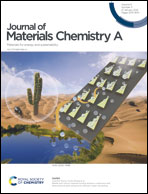Enhanced thermoelectric performance in Mg3+xSb1.5Bi0.49Te0.01via engineering microstructure through melt-centrifugation†
Abstract
N-type Zintl phases with earth-abundant and non-toxic constituent elements have attracted intense research interest thanks to their high thermoelectric efficiencies in the mid-temperature range, exemplified by the recently discovered Mg3Sb2 material. In this study, the liquid phase is expelled from the microstructure of the optimized n-type phase Mg3+xSb1.5Bi0.49Te0.01 by applying a melt-centrifugation technique leading to the formation of lattice dislocations, grain boundary dislocations and increasing porosity. Additional phonon scattering mechanisms were introduced in the microstructure through this manufacturing method, resulting in a significant 50% reduction in the total thermal conductivity from ∼1 W m−1 K−1 to ∼0.5 W m−1 K−1 at 723 K. Combined with high power factors, this reduced heat transport leads to a dimensionless thermoelectric figure of merit, zT, value of ∼1.64 at 723 K, 43% higher than the value obtained in untreated Mg3+xSb1.5Bi0.49Te0.01 (zT ∼ 1.14 at 723 K). This peak zT value yields a predicted device ZT of 0.95, and a promising theoretical thermoelectric efficiency of about 12%. These results further underline the great potential of the lightweight Mg3Sb2 material for mid-temperature energy harvesting via thermoelectric effects.



 Please wait while we load your content...
Please wait while we load your content...
